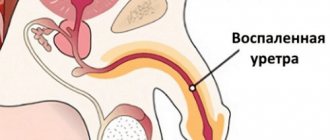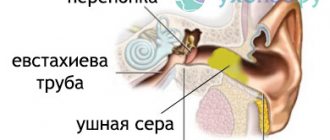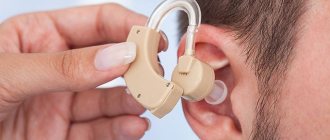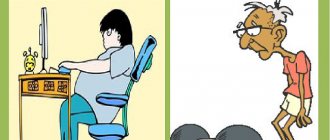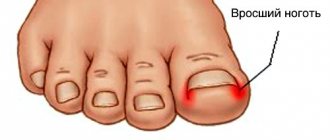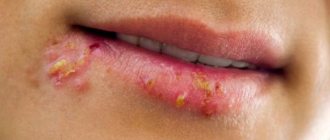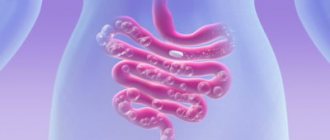≡ November 2, 2020 Category: Complications
When a person has difficulty hearing with otitis media, this can happen for several reasons, depending on the location of the inflammatory process:
- In the outer part of the ear, the ear canal is partially blocked, limiting the ability of sound vibrations to enter the tympanic region of the ear.
- In the middle part of the ear, an accumulation of pus interferes with the normal functioning of the sound-transmitting bones - the malleus, incus and stapes.
- In the inner ear – inflammation that spreads to the inner part of the ear can cause errors in the conversion of sound waves into nerve impulses.
Normally, ear congestion should go away after treatment. But 5% to 10% of patients complain that they still have ear congestion after otitis media.
Causes of stuffy ears
Most often, patients only have one ear blocked. In this case, it seems to the patient that congestion has arisen suddenly, but he might not have detected this sign right away.
Causes of ear congestion on one side:
- Inflammation of the nasal passages - with rhinitis, inflammation of the nasal mucosa occurs; as this process develops, the inflammation can spread to the throat and ears. Lack of timely treatment of rhinitis provokes sinusitis; in severe cases, pus can enter the brain.
- Acute eustachitis is an inflammatory process that occurs sharply in the eustachian tube, which connects the middle ear and throat.
- Otitis media is an inflammation of the ear that occurs when the cavity becomes infected or due to hypothermia.
- Entry of a foreign body - the ear suddenly becomes blocked when insects or other foreign bodies enter the cavity.
- Ingress of water - the ear can become suddenly blocked when diving or while washing; if water does not come out of the ear for a long time, this can lead to swelling of wax accumulations and the formation of cerumen plug.
- A sharp change in the pressure ratio on the inner and outer sides of the auditory tube occurs during a sharp takeoff or dive to a depth; in addition to ear congestion, dizziness also occurs.
In some situations, both ears are blocked at the same time. The most common reasons:
- The use of drugs that have ototoxicity - ristomycin, amitriptyline, carbamazepine, as well as other antibiotics, when taken for a long time, provoke bilateral hearing loss.
- A sharp change in the pressure ratio - during takeoff or diving to depth, can suddenly cause both ears to become blocked at once.
- Bilateral ingress of water - ingress of water during bathing or showering provokes ear congestion, which goes away on its own when fluid flows out of the ear cavity.
- Heatstroke - when overheated, ear congestion occurs due to excessive vasodilation, headaches and dizziness, and a feeling of extreme thirst also occur.
- Arterial hypertension - both ears become blocked when blood pressure rises, and tinnitus, headache, and attacks of nausea also occur. If hypertension develops, you must take an antihypertensive drug prescribed by your doctor.
- Bilateral otitis - an inflammatory process in both ears must be treated immediately, otherwise the inflammation can spread to the brain and provoke the development of meningitis. The disease also causes tinnitus, headaches, and increased body temperature.
Pathological causes
Sometimes the explanation for why the ear is blocked can be an allergy. It is worth remembering that the ears, nose and throat are connected into a single system. If the allergen enters through the mouth or nose, the resulting irritation can also affect the hearing organs. So don’t be surprised if you have one ear or both when you have allergies. Treatment consists of taking nasal antihistamines prescribed by your doctor. Consultation with a specialist is required, otherwise you may harm yourself.
A cold is another cause of discomfort in the ear canal. Due to the inflammatory process, swelling develops in the ear, which leads to congestion and pain. If you have a runny nose, your nose becomes blocked, and when a person tries to breathe, negative pressure arises in the ears, which can also cause them to become stuffy. Unlike allergies, such congestion can intensify as the disease progresses, and it will be possible to get rid of it only when the main symptoms pass. What to do if you have a stuffy nose and ears due to a cold? Rinsing with a saline solution will help relieve symptoms. But you can’t overdo it with salt, maximum 1 tsp. for 0.5 liters of water.
Is your ear blocked and hurting? The cause may be otitis of different etiologies:
- Otitis externa. The disease appears when there is local inflammation of the ear canal. If you pull a person by the ear, the pain becomes stronger. Most often, the disease develops due to a boil or eczema of the ear canal.
- The cause of otitis media is rhinopharyngitis.
- Otitis of the inner ear. This phenomenon is extremely rare, but is more severe.
When one or both ears are clogged, and there is no opportunity to contact an otolaryngologist, the following remedies will help:
- Roll up a cotton swab soaked in a water-alcohol solution and place it in the ear canal. Ears should be wrapped with a scarf or warm scarf.
- Place a few drops of onion or garlic juice in each ear: they are excellent antibiotics.
- If special drops are not available, you can use a folk remedy: moisten a cotton swab in a tincture of calendula, chamomile or eucalyptus. These herbs have both anti-inflammatory and antiseptic properties.
- Camphor oil is also often used for instillation of sore ears.
If there is congestion, it is necessary to exclude eustachitis, a disease that occurs as a result of inflammation of the Eustachian tube, which connects the middle ear to the pharynx. The disease most often develops against the background of influenza, ARVI and other ailments of a viral and bacterial nature. Congestion is accompanied by noise and pain in the ears, a feeling of pressure inside them, autophony (a condition in which a person hears his own voice and breathing in the sore ear). Treatment of the disease is carried out with drugs with a vasoconstrictor and anti-inflammatory effect.
Sometimes the ears become blocked due to high blood pressure. This occurs due to vasospasm and impaired blood flow. As soon as the pressure returns to normal, the discomfort will disappear. But they can also occur with hypotension, which is a consequence of deterioration of vascular tone. The walls of the capillaries become thinner, and their permeability increases. As a result, swelling of the mucous membranes of the ENT organs, including the Eustachian tube, occurs. Its lumen decreases, a vacuum appears in the cavity of the middle ear, which is why congestion appears. Poor blood flow in the vessels of the brain can also be caused by cervical osteochondrosis, which will lead to unpleasant sensations in the hearing organs.
People who ask the question: “Why are my ears stuffy?” do not always realize that the cause of discomfort sometimes lies in a deformed nasal septum. This pathology most often affects men. A deviated nasal septum may be associated with an abnormal structure of the bones of the facial part of the skull or result from an injury. From people with this disease you can hear complaints of frequent sinusitis, problems with nasal breathing, and night snoring. The pathology is eliminated through surgery.
Head injuries and blows directly to the ear, which can be received not only in a fight, but also simply from a fall, can also cause congestion in the ear canal. In this case, it is necessary to see a specialist as soon as possible in order to eliminate the risk of developing serious pathologies. To eliminate congestion, you need to determine which part of the ear is injured - internal, external or middle. Then the doctor will be able to recommend adequate therapy.
You should not self-medicate, even if the hearing organ is blocked, but does not hurt. It is necessary to consult a doctor, especially when the symptoms begin to progress. Viral diseases can cause complications in the form of deterioration of auditory reflexes.
What can you do
If ear congestion is caused by non-pathological causes, such as a sharp takeoff, diving to depth or water ingress, then the symptom does not require any treatment. The congestion goes away on its own within a few minutes.
If a foreign body gets into the ear, you must immediately seek help at the nearest emergency room. Under no circumstances try to remove the item yourself; you may damage the inner ear and cause inflammation.
If you have heatstroke, sit or lie down in a cool place, place a cold, wet compress on your head, and drink water.
You will learn more about what to do if your ears suddenly become blocked in this video:
Rhinitis and otitis require drug treatment. Consult a doctor, after examination and necessary diagnostics, the specialist will prescribe medications. To eliminate inflammation in the nasal cavity and ears, special drops are used. Symptomatic treatment may also be prescribed for these diseases. If the temperature rises above 38 degrees, take Paracetamol.
For arterial hypertension, to relieve ear congestion and lower blood pressure, take an antihypertensive drug prescribed by your doctor. You can lower blood pressure with motherwort tincture.
What to do if your ear is blocked after otitis media
To treat ear congestion, a comprehensive treatment is required, which should be prepared by an otolaryngologist. Before a course of therapy, it is necessary to undergo an examination to ensure that the diagnosis is correct.
If ear congestion is caused by otitis , the patient is prescribed vasoconstrictor medications. This can be either ear or nasal drops. In addition, the patient necessarily needs decongestant medications in order to reduce inflammation in the mucous membrane of the ear.
In addition, it is necessary to free the Eustachian tube from fluid that passes from the middle area of the ear. For this, the patient is prescribed anti-inflammatory medications.
Eliminate mucous discharge from the nose. This is necessary to normalize breathing.
You need to understand that ear congestion does not go away immediately after ear restoration. Therefore, symptoms such as heaviness and congestion may be present for about ten days after complete recovery . If swelling and loss of hearing acuity do not go away for a long time, the patient is prescribed additional treatment.
In the case of purulent otitis, ear congestion will last until the tympanic area returns to its natural state.
Answering the question of how long the ear is blocked with otitis media, it all depends on the type of inflammation. Therefore, to treat complications of otitis media, it is necessary to establish the root cause of inflammation.
So, if the body is infected with harmful bacteria , they must be removed from the body through medication. But identifying their presence is quite difficult. This procedure is performed under a microscope.
If otitis is caused due to problems with the anatomical structure, congestion in the ear goes away only after
septoplasty - surgery to correct the shape of the nasal septum.
Surgical intervention in case of pathology is necessary, but after it is performed, the risk of diseases of the ear and nasopharynx decreases many times.
If otitis media is caused by a cold, the patient is prescribed medication aimed at eliminating swelling and inflammation. In addition, the patient is prescribed nasal drops to restore breathing.
After a course of treatment, the patient’s Eustachian tube functionality is restored. To maintain the effect, the patient is prescribed phytosuppositories and physiotherapy.
If there is congestion in the ears for a long time, antibiotic therapy is prescribed. This is necessary in extreme situations when the patient has acute or purulent otitis media. Antibiotics quickly eliminate the source of inflammation. The patient feels significant improvements already on the third day of use.
Exercises
In addition to the listed treatment methods, the patient can perform specialized exercises. They are effective for long-term congestion. In addition, they can be performed at home, which is a big advantage of this treatment.
To implement this method, study the following rules:
- First, the patient needs to increase the load on the hearing organ. Chewing gum is considered the best method. Chew it for an hour and thereby you will develop the middle ear.
- Pinch your nose when drinking liquid.
- Blow balloons or soap bubbles every hour.
- To clear the auditory tube, start singing.
- Open your mouth slightly and imitate a yawn.
- Take warm water treatments.
If you do not notice the results of these exercises, seek qualified help from a physical therapy . Typically the patient is prescribed the following procedures:
- Blowing.
- Magnetotherapy.
- Laser treatment.
- Ultrasound treatment.
- Pneumomassage of the ear.
Remember that if you have mucous discharge from your nose, get rid of your runny nose before visiting a medical facility.
What to remember
- Severe congestion of the ear or both ears occurs due to inflammatory processes in the auricle and nasal cavity, with hypertension and heat stroke, as well as when water and a foreign body enter the cavity of the auditory organ.
- Treatment of the symptom depends on the cause of the congestion. If additional symptoms occur, contact a specialist.
- Do not start the progression of inflammatory diseases in the ears and nasal cavity, this can lead to the development of meningitis and sinusitis.
When will ear congestion go away after otitis media?
Doctors often, seeing that there are no signs of otitis media and other pathologies do not clearly manifest themselves, say that deafness will go away with time. And in most cases this is true. The persistence of ear congestion for a short period of time after otitis media is considered normal for the recovery period.
To speed up the process, physiotherapeutic procedures are prescribed: blowing the auditory tube, warming up.
It usually takes about two weeks for congestion to go away.
Stuffed ears after swimming: what to do
Ears blocked after swimming, Lechu.ru
Water getting into the ears is the most common cause of blocked ears. Usually the fluid drains from the ears on its own, after which hearing returns to normal. In this case, you can only speed up the process:
- To do this, take a piece of gauze and roll it into a tube. This way you can make turundas, which are widely used in medicine. Stick it in your ear, but not too deep.
- If only your right or only your left ear is blocked, lie on a pillow with it. Lay down a towel and just wait until the water starts flowing.
Although this does not pose a particular threat, some argue that there is no need to extract the water. But there is a risk of developing an infection in it.
Etiology of congestion
Having determined the true causes of congestion, you can begin to eliminate them. But it is better, of course, to be examined by an ENT doctor so that he can find any damage to the membrane, the type of flora (pathogenic) that caused the complications.
Ear congestion may occur due to:
- sinusitis;
- otitis (initial stage);
- rhinitis;
- Frequent nose blowing often leads to dysfunction of the auditory tube.
Symptom relief should begin with eliminating the main causes of its occurrence (ARVI). Congestion in the ears in time for a cold can be eliminated with the help of:
- systemic drugs against viruses;
- special exercises;
- compresses with oils (warming);
- nasal drops that constrict blood vessels;
- ear drops against inflammation.
Treatment methods
If the cause of the disease is already known, understanding how to treat ear congestion at home is not so difficult. You cannot eliminate congestion on your own, because there is a risk of complications. If problems with the middle ear, otitis of various etiologies are identified, then treatment is prescribed and monitored by an ENT specialist. If foreign objects get in, you should also consult a doctor. You can get rid of water that has gotten into your ear on your own - it can be easily evacuated if you tilt your head, creating conditions for it to flow out.
Drug therapy
A list of special medications for the treatment of a disease can only be issued by a doctor. Treatment for seemingly identical otitis may differ, if only because of the presence or absence of perforation of the eardrum. Common to all cases is the appointment of vasoconstrictor drops in the nose. They help relieve swelling in the Eustachian tube. Vasoconstrictor drops include:
- Naphthyzin;
- Nazol;
- Galazolin;
- Sanorin.
The following medications are often used to treat otitis media:
- Ear drops with antibiotics – Cipropharm, Normax, Otofa.
- Combined drops - Sofradex (antibiotic and corticosteroids anesthetize), Candibiotic (antibiotic, antifungal component and lidocaine anesthetize, treat fungus).
- Antiseptic – Miramistin.
- Ointments against fungus – Clotrimazole, Pimafucin.
Doctors prescribe antibiotics in tablets or injections in severe cases, for example, when otitis media appears against the background of a sore throat. Physiotherapy, Politzer blowing, and pneumomassage of the eardrum are prescribed in parallel with drug treatment. In severe cases - eardrum bypass or paracentesis, catheterization of the auditory tubes.
Removing traffic jams
Earwax plugs appear more often in children, since the child’s ear canal is not yet fully developed. It is narrower than in adults, so the risk of earwax accumulation, which creates a plug, is much higher. Diagnosing a plug in the ear is simple: there is discomfort and itching in the ear, hearing acuity decreases, and the patient feels stuffy. There are several ways to get rid of an ear plug:
- rinsing (done by a doctor);
- blowing;
- removal with hydrogen peroxide solution;
- treatment with special preparations (drops) or phytosuppositories.
You cannot do the washing and blowing procedure yourself; only doctors will remove the plug correctly. Trying to clear the plug yourself by blowing your ear can be dangerous. If you damage your eardrum, you can go deaf. At home, you can safely remove the plug in the following ways:
- Drops like A-Cerumen or Remo-Vax need to be dripped for several days, according to the instructions. They dissolve earwax, so they facilitate easy removal of the plug. Before use, consult a doctor, as components may cause individual intolerance.
- Hydrogen peroxide. Apply peroxide as drops for several days until the plug is completely dissolved and its particles are washed out of the ear canal. A drop of peroxide should be kept in the ear canal for up to 10 minutes. The fizz from the peroxide may cause discomfort, but it is minor.
- Ear candles. Candles made using natural wax and propolis help draw out earwax and warm up the ears. They can be used even if your ears hurt a lot. The pain begins to go away after the first procedure. A candle can replace a warm compress if your ear is cold.
Why are my ears clogged?
Why my ears are blocked, www.mdcs.ru
There can be many reasons for blocked ears. Speaking about the anatomical aspect, obstructions are the consequences of blocking the eardrum. It is she who is responsible for the volume of hearing and human hearing.
Popular articles now
Near Lvov, a university teacher stuck his head in a noose—the suicide notes explained everything
Coronavirus outbreak leads to production of realistic face masks, photo
In Ukraine, free customs clearance is being introduced, the main pitfalls are named
The network showed a secret scheme of how Vodafone despicably cheats pensioners out of money
show more
Moreover, the membrane can be blocked both from the inside and from the outside.
Reasons for stuffy ears:
- Sudden jumps in blood pressure. They often occur while flying on an airplane. It can also be caused by a long ascent or descent to a great height in an elevator. The blockage occurs due to the coincidence of pressure from outside the ear, from the inside and in the environment. Among the main symptoms that indicate that the ears are blocked due to pressure changes: pain, hearing loss and a feeling of fullness.
- Otitis. Viruses, various kinds of bacteria and fungus become the causative agents of inflammation of the middle ear. The infection is accompanied by fever, ear pain, hearing loss and discharge. If the inflammation is purulent, there is a sensation of rolling fluid deep in the ear. The infection rarely comes on its own. In most cases, otitis is a consequence of infectious diseases in the throat or nose that reach the ears through the Eustachian tube.
- Traffic jams. The ears produce wax, which sometimes accumulates in the ear canal, clogging it and thereby preventing the auditory system from functioning correctly. Due to sulfur plugs, hearing deteriorates and a feeling of stuffiness occurs. Usually, the occurrence of sulfur plugs cannot be foreseen, since they are in no way related to diseases or external irritants.
- Water getting into the ear. The presence of water in the ear is easy to detect on your own, based on your own sensations. Water will roll over your ear.
- A foreign object has entered the ear. This reason is common among children. Small objects and toys often end up in their ears. Do not try to rinse your ear yourself.
- Runny nose. The Eustachian tube closely connects the ear system with the nose and pharynx. It can swell even with a normal runny nose (both caused by infection and allergic).
- Infection in the external auditory canal. Main symptoms: severe itching in the ear, pain and discharge. Typically, this kind of infection gets into the ears while on vacation, in the water. And further develop in the ear canal. The risk of infection increases if there are minor scratches in the ears.
What to do to get rid of ear congestion depends on what caused it.
How does congestion occur?
The hearing organs in healthy people function like this:
- sound waves are captured by the ear;
- in the ear canal, sound vibrations move to the eardrum, located between the outer and middle ear;
- Then the sound is amplified and converted into electrical impulses.
The feeling of ear congestion is nothing more than a disturbance in the passage of sound to the auditory analyzer. This is possible in two situations - if there are obstacles in the path of the sound wave that block its progress through the ear canal, or when the perception of sound signals by the eardrum is impaired.
A decrease in auditory sensitivity indicates the presence of barriers to the passage of sound or the development of dysfunction of sound-receiving organs.
In what other cases is self-medication unacceptable?
It is strictly forbidden to engage in self-therapy if the cause is a foreign body. Only a doctor knows how to remove a foreign object without the risk of injuring the eardrum. If you do it yourself, the risk of rupture of the eardrum and loss of hearing is too high. If the victim himself gets rid of the foreign object due to the inability to see a doctor, only clean water can be used for rinsing.
Also, you should not self-medicate if the causes of ear congestion are associated with defects in the structure of the nasal septum. Until they are eliminated, it will not be possible to relieve congestion.
When the ear is blocked due to high blood pressure, treatment should be aimed at normalizing it, and not at relieving the symptom. Since hypertension is a life-threatening disease, it must be treated by a doctor.
Treatment of ear congestion with medication
To eliminate ear vacuum, the doctor prescribes either physical therapy, surgery, or medication. To get rid of this symptom, many types of medications are used, for example:
- drops for inflammation (“Sufradex” or “Otipax”) - regresses inflammatory foci in the Eustachian tube and in the nasopharynx;
- medicines against bacteria (Amoxicillin) - help destroy bacteria leading to purulent otitis media;
- drops for vasoconstriction (“Snoop”) - thanks to them, vascular permeability is reduced, which helps restore ventilation of the cavity (tympanum) and which leads to an increase in the diameter of the (internal) auditory canal;
- antifungal agents (“Amphoglucamine”) - help reduce the activity of yeast-like and mold fungi that cause otomycosis;
- drugs against viruses (Remantadine, Kagocel) - destroy viruses that provoke external otitis of diffuse and bullous type.
2Eliminating ear congestion at home
- If congestion was discovered after visiting a pool, swimming in a river or other body of water, or diving, then most likely water got into the ear and it is the water plug that is the cause of the discomfort. How to get rid of unpleasant feelings? You need to tilt your head to the side, exactly the side on which your ear is blocked, and wait until the water flows out. Sometimes this does not happen immediately, and you need to wait a few minutes, but usually the water is eliminated from the ears on its own and the congestion goes away after that.
- Ear congestion also accompanies colds. Here you need to be more careful. Of course, you should definitely report this unpleasant symptom to your doctor, but if this is not possible or you were able to make an appointment only after a few days, then in order not to worsen the situation and not start the spread of infection, you can drop antibiotic drops into your ears, for example Otofa or Sofradex . They will prevent ear inflammation and prevent pain from developing.
- If the congestion is the result of a runny nose and careless blowing of the nose, then you should drop any vasoconstrictor into the nose, and the congestion will go away. But if a runny nose has become a platform for the development of otitis and you already feel unpleasant symptoms in your ears: pain and shooting, then you can start dripping Albucid or Otium drops.
- If you feel that your ears are not only blocked, but you also have difficulty hearing, then you need to urgently consult a doctor, and before taking it you can drip Sodium Sulfacyl, it is sold in any pharmacy and is freely available, since it is not a prescription drug .
- If you understand that the cause of congestion is earwax, and there is no opportunity to go to the doctor or go to the pharmacy for a special product to soften ear plugs, then drop 3-5 drops of hydrogen peroxide into your ear, tilt your ear and wait until the peroxide stops hissing. You need to carry out this procedure three times a day for 5 days. The plug will soften and come out, and the feeling of congestion will disappear.
Traditional methods of therapy
Folk remedies for ear congestion are used as an additional treatment for inflammatory diseases. Their use must certainly be agreed upon with a doctor. If your ear is blocked, how to treat it is decided by a specialist, since a home remedy cannot always be combined with a prescribed drug for traditional therapy.
- When the ear is blocked, a geranium leaf helps a lot. It is rolled into a tube, inserted into the ear and left overnight. If your right ear is blocked, it is advisable to sleep on your left side and vice versa.
- Geranium essential oil is also an effective remedy. It is applied to a cotton swab and placed in the ear. Stay with the tampon for 15 minutes. If the left ear is blocked, then they remain lying on the right side, and vice versa.
- When your ears are blocked, tea tree oil is an effective remedy. It is used in the same way as geranium oil, by inserting a tampon for 15 minutes and remaining lying with the sore ear facing up.
- You can use heated formic alcohol. It is slightly heated and then instilled into the sore ear. After administering the medication, lie on the side opposite the affected ear for at least 10 minutes.
How to treat a stuffy ear, using additional folk remedies, everyone should choose for themselves, but taking into account medical recommendations, the individual characteristics of the body and allergic reactions.
Drug treatment for ear congestion syndrome
Since the causes of ear congestion can be different, treatment is prescribed according to them:
- vasoconstrictor drops, which will temporarily relieve swelling of the nasal mucosa during a runny nose (Tizin, Nazol, Naphthyzin, etc.);
- anti-inflammatory ear drops for otitis (Otipax, Otinum) and with antibiotics for severe cases (Sufradex, Dexon);
- antiviral drugs (Rimantadine, Kagocel) speed up the recovery process for colds, swelling subsides, ear congestion goes away;
- antibiotics for acute otitis media, inflammation of the facial nerve and other serious diseases;
- drugs that lower blood pressure for hypertension (Dibazol, Papaverine, Captopril, Losartan, Felodipine);
- drugs that normalize blood pressure and restore vascular tone in VSD and Meniere's syndrome (Tonginal);
- drugs that increase blood pressure (Askofen, Ketorol, Ibuprofen);
- antihistamines (Citrine, Diazolin, Suprastin, Vibrosol) for allergic reactions leading to swelling of the mucous membranes and stuffy ears;
- alcohol drops for the ears (Auridexan) and alcohol compresses.
Take your health seriously; if your ears regularly clog, consult a specialist, and do not self-medicate.
